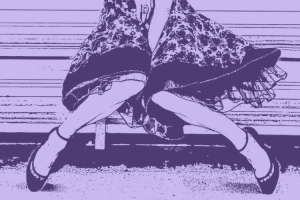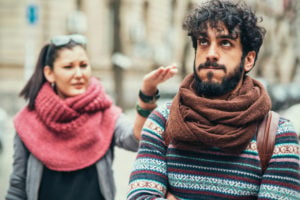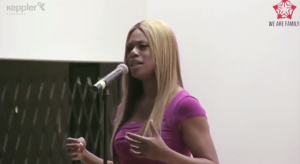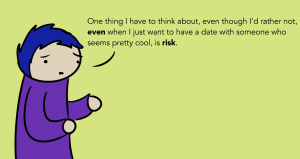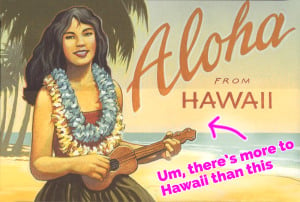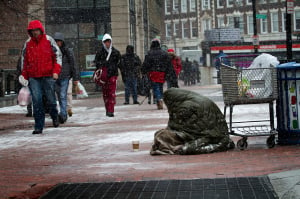
A young person on a black backdrop touches their thumb to their face, looking off to the side thoughtfully.
There are certain things that aren’t meant to be “one size fits all.”
From clothing to food, the idea that one thing can be everything for every person is an unrealistic and unhealthy expectation to have. But when it comes to race, we tend to shy away from the much-needed nuance that comes with applying this “one size fits all” thinking.
Online, in spaces dedicated to better understanding how to incorporate social justice into our lives, we’re encouraged to have these conversations and approach these challenges head-on.
And while it’s important that we have these spaces to freely interact and learn from each other, it also leaves much room for oppression to emerge in other ways.
Language is often one of the last forms of oppression to be challenged – because how do we tackle something so essential to how we communicate with the world and each other? But language is one of the most powerful ways to create change or uphold oppression for that very reason.
Diversity culture, or this push to challenge the societal norms that subconsciously support heteronormative whiteness at the cost of all others, could be responsible for how the term people of color can be used maliciously – albeit unintentionally.
In an effort to raise awareness without fully understanding the implications of how to incorporate a better foundation for equitable solutions, we’re contributing to the same system by handing it another tool.
Ironically, the trap of people of color can be permitted by the very people who identify as such – mainly by non-Black people of color, who in their efforts to raise awareness against oppression, continue to rely on exploitation and subconscious violence rooted in language.
Lately, language has pushed to better encompass the sensitivity and awareness needed to navigate within racial identity and ethnicity. But the term people of color – an umbrella term used to encompass everyone who identifies as someone from a non-white background – can be the easiest way for us to fall in the trap of “one size fits all” thinking.
And what’s worse, the term people of color can contribute to the violence that specific communities face every day in a white supremacist society.
It’s essential that all of us – whether we identify as a person of color or not – commit to doing the work of understanding how language plays a role in perpetuating violence.
We have to look at the foundation that it rests on, and fully understand how we need to rework our ideas of liberation and solutions to find one that is equitable and ethical for everyone – and doesn’t just eradicate surface issues.
So how exactly can the term people of color contribute to this culture of violence, and how can we overcome it?
Here’s a look.
1. Racism Affects Different Groups Differently
There’s no doubt that being a victim of racism isn’t exclusive to just the Black community.
All non-white communities have found themselves victim to racial violence at the hands of white supremacists. However, just because we’ve all experienced various instances of racial violence doesn’t mean that these instances are equal.
Large-scale movements try to encompass all of our struggles under one umbrella movement to create unity and community. And while that’s all well and good, it can become harmful when we allow for these ideals to seep into how we approach systematic and institutional issues like racism.
That is, the individuality and intersectionality of how we approach violence isn’t a bad thing. But if used incorrectly, it can be.
Other important factors – like class, visibility, and colorism – play a significant role in which communities are most vulnerable to large-scale racial violence.
White supremacy thrives on assuming whiteness as the ideal, so communities where the members embody qualities similar to whiteness – be it skin tone, facial features, or proximity to other Eurocentric qualities – that are less likely to be victims of these race-based violence.
That being said, we have to examine how we approach and examine our own ideas of racism and internalization in order to make a difference.
Because white supremacy is so pervasive, it’s particularly violent towards Black people – mainly because of colorism, or the idea that one’s skin tone makes them more or less worthy of humanity based on their proximity to whiteness.
Generally, Black people are visibly more vulnerable to being targets of racial violence because we’re visibly othered – because of our darker skin tones and distinct features that other ethnic groups don’t exhibit.
The idea that all communities of color are affected equally by racial violence is damaging because it undermines the very real pain and suffering that we face.
2. Specific Community Names Are Important
In reality, there are few instances where it’s appropriate to bring all non-white communities under a universal umbrella. But largely, erasure plays out every day with the language that we use – mostly by not being specific.
By using “people of color” instead of specific community names, we contribute to erasure by insinuating that all ethnic groups are interchangeable – which we know is not true.
The inequity of power that communities of color have within our white supremacist society needs to be acknowledged, so that we have a better framework for reworking activism and allyship between our communities themselves.
Communities of color can rely on each other for support when violence strikes us, yes. But to assume that all of our struggles and challenges are the same is dangerous – especially considering the historical and long-rooted violence that many communities of color face.
And because all communities don’t undergo racial violence on the same plane, it’s even more important that we’re respectful by being as specific as possible in our conversations.
When specific instances of violence make their way into the mainstream, we focus on the victims and the immediate community that was affected. To do otherwise is insensitive and allowing erasure.
3. Ignoring Nuances in Experience Contributes to Erasure
Many allies have the impression that saying specific communities by their name – particularly the Black community – can be disrespectful because of the difficult and racially charged history that comes along with it.
However, there’s more harm than good done when we lump all non-white communities together.
There’s also the challenge of introducing how challenges affect various communities, but especially those that identify as bi- or multiracial. These individuals often find themselves completely erased from conversations around racial violence, despite being integral in these conversations.
There is power in breaking silence and in speaking your truth. But it’s more than that: There is power in speaking the specific names that link us to the various parts of our identity – our names, our community names, and the various other labels that we carry with us link us to all that we are and the communities that we feel a part of.
4. It Can Unwittingly Reflect Anti-Blackness
Anti-Blackness, or the paradigm that holds Black people and Blackness as inherently the worst things we can be, are some of the most challenging instances of racial violence that we’ve yet to overcome.
White people aren’t the only ones that can inhibit anti-Blackness – anti-Blackness and white supremacy are deeply rooted within many non-Black communities.
From colorism to wide-scale erasure, anti-Blackness is central in the racial violence that we experience. So the first and most important step to combat this is to acknowledge the ways that we may be subconsciously contributing to the power of anti-Blackness.
How has anti-Blackness shifted the way that you approach racial violence? Can it be linked to your views of victim blaming and intercommunity violence? Does it also affect how you view activism – the expectation of Black activists indulging in performative labor for non-Black communities?
These are all ways that anti-Blackness can be explored and expressed that link directly to the violence that we face.
The dangerous allure of racial violence is that often, it’s made so that communities of color themselves can be oppressive. We’re fully capable of being oppressive and oppressed simultaneously, for various reasons – all rooted in where we have the most or least amounts of privilege and vulnerability.
Often, when we only bring ourselves to label all non-white communities as people of color, we’re contributing to a culture of erasure and long-standing violence.
And just as white supremacy and anti-Blackness can be exercised from a variety of communities, it’s also the responsibility of all communities to understand how to combat the erasure and violence that can come from the forced “kumbaya” of all communities of color.
***
We’re able to recognize that we have power in our unique identities, and be allies in supporting other communities of color against white supremacy and violence. However, we do more harm than good by lumping us all together under a forced umbrella of false equality.
Communities of color are powerful and worthy of being acknowledged specifically. To combat the violence and white supremacy that we face each day, we need to be able to confront the ways that we contribute to mass erasure and institutional violence against our communities.
[do_widget id=’text-101′]
Cameron is a writer, emerging sex educator, and professional fangirl from New Jersey. Her work has been featured in Glamour, Harper’s Bazaar, ThinkProgress, and others. She’s also an avid fan of dying her hair obnoxious colors. Follow Cameron on Twitter @BlkGirlManifest.
Search our 3000+ articles!
Read our articles about:
Our online racial justice training
Used by hundreds of universities, non-profits, and businesses.
Click to learn more






